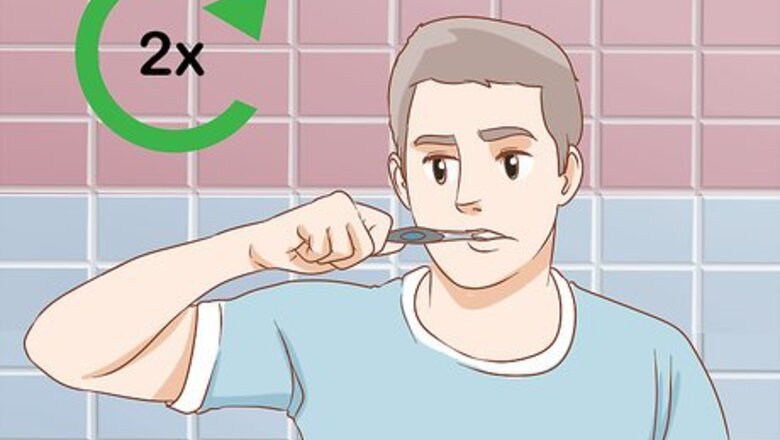
views
X
Trustworthy Source
MedlinePlus
Collection of medical information sourced from the US National Library of Medicine
Go to source
Practicing Good Oral Hygiene

Brush your teeth twice a day. One of the best ways to treat gum pockets is to brush on a regular basis. Use a soft-bristled toothbrush and brush your teeth gently, as hard bristles and rough brushing can cause the gums to recede further. However, brushing both morning and night will help remove all of the food and bacteria that gets lodged in the pockets. If you are really focused on reducing your gum pockets, try brushing after every meal. This will prevent the area that needs to heal from being exposed to more bacteria and food.

Opt for using an electric toothbrush. Make sure your electric toothbrush is charged. Once it has power, put a small amount of toothpaste on it, put it in your mouth, and then turn it on. Clean your teeth in quadrants, focusing on one quarter of your mouth at a time. When done, turn off the toothbrush, spit out your toothpaste, rinse out your mouth, and rinse off the brush head. An electric toothbrush will be able to clean down deeper into the pockets than a traditional toothbrush. Since it’s better at cleaning below the gum line, it’s a good idea to use one if you are trying to help your gums heal.
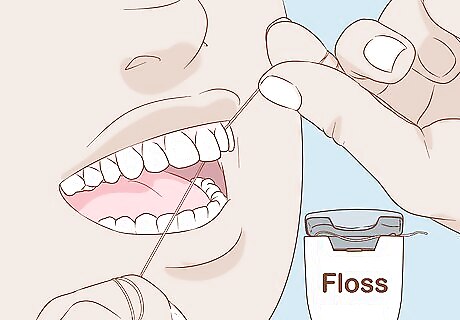
Floss at least once a day. Floss can get in between the teeth and remove food that a toothbrush just can’t get. When flossing, use about 18 inches (46 cm) of floss, hold it between your thumb and forefinger in each hand, and insert it between your teeth using a rubbing motion. Once between your teeth, wrap it in a “c” shape against each of the teeth it is between and rub the area gently. It's important not to snap the floss into the space between teeth, as this can injure the gums. Using a gradual rubbing motion instead will prevent the chance of injuring the gums further.
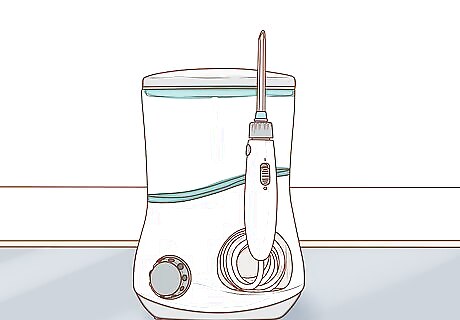
Use a water flosser to clean between your teeth and gums. Water flossers are machines that clean by shooting water between the gums and the teeth. To use one, you fill the water reservoir with water, position the head so it’s pointed at your teeth, and turn on the machine. Once the water flosser is going, follow the gum line and clean between all of your teeth. They are available at most big box stores, as well as from online retailers. While dental floss can get down a few millimeters into your gum pockets, water flosser machines can get down much further. This helps to clean out all the germs and debris in the pockets that could make them bigger.
Using Home Remedies

Do a salt-water rinse 2-3 times a day. Mix 1/2 to 3/4 teaspoon of salt into a 8 fluid ounces (240 mL) glass of lukewarm water. Take some into your mouth and swish it around. Do this for 30 seconds and then spit it out. Use this rinse 2 to 3 times a day to clean out your gum pockets and to help them heal.

Use an essential oil mouthwash. There are a variety of essential oils that will help with the health of your teeth and gums. Add 2-3 drops of tea tree, lemongrass, clove, or basil essential oil to an 8 fluid ounces (240 mL) cup of warm water. Swish the rinse in your mouth for 30 seconds and then spit it out in your sink. Do this once or twice daily to help your gums. Essential oils can be purchased at natural food stores and from online retailers. Look for products that are labeled "food grade," as you will be putting it in your mouth.

Consider using oil pulling. Oil pulling is a process in which you swish a small amount of oil, typically coconut oil, around your mouth to clean it. Put 1 to 2 teaspoons in your mouth and move it around your teeth for 5-20 minutes. After you are done swishing, spit it out and brush your teeth. Repeat this process every time you intend to brush your teeth. If swishing the oil hurts your jaw, do it for just 5-10 minutes. If you like, do this twice a day to get to the full 20 minutes. This technique pulls toxins and bacteria out of the pockets in your gums, allowing them to heal more effectively. While this technique is considered new and under researched in some parts of the world, it has been used for a long time in cultures that rely on ayurvedic medicine.
Use xylitol gum, mints, or mouth rinse to improve your dental health. Xylitol is a natural sugar alcohol that can limit the progression of gingivitis and may improve your gum health. It's a common ingredient in sugar-free gum and mints. Additionally, you can buy granulated xylitol in the baking aisle of your grocery store. Use your xylitol products 2-3 times per day. Make sure that xylitol is the first ingredient in your gum or mints. You can find a xylitol rinse on the dental care aisle, or make your own by mixing 1/2 tsp (4 g) of granulated xylitol into 8 fluid ounces (240 mL) of warm water.

Take supplements that will improve your gum health. There are certain nutrients that can increase your body’s ability to heal your gums. These include, but are not limited to, omega-3 fatty acids, probiotics, and calcium. Talk to your doctor about whether taking these supplements is right for you and what amount you should take. Supplements are typically available at natural health food stores and from online retailers.
Making Lifestyle Changes
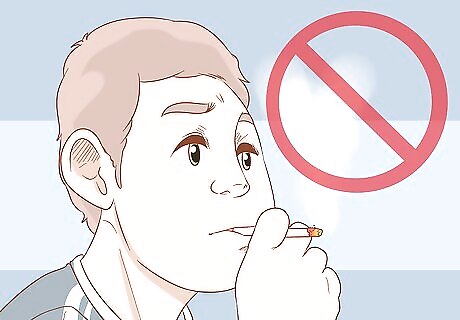
Quit smoking. Smoking can have a horrible effect on the health of your teeth and gums. In order to reduce your gum pockets, it’s important to stop smoking. Even reducing the amount you smoke can have a positive impact, so do what you can. If you have a hard time stopping on your own, talk to your doctor about ways they can help you with your goal of quitting smoking. They may be able to suggest programs you can join and medications that can help you quit.
Stop drinking alcohol. Alcoholic drinks can cause or worsen gum disease, so it's best to stop drinking it. Eliminate beer, wine, liquor, and mixed drinks from your diet. Try replacing alcohol with non-alcoholic mocktails. If you're having trouble quitting, talk to your doctor or join a support group.

Reduce the number of sugary foods you eat and drink. Sugary foods, such as soda and candy, can hurt your gums and increase the size of your gum pockets. Cut them out of your diet if possible in order to let your gums heal without having to contend with sugar as well. If you can’t cut sugar out completely, be sure to brush your teeth after eating or drinking it. However, if you are eating something that is sweet and acidic, such as soda pop, you should actually wait for a few minutes after eating it to brush. If you brush while the acid is still on your teeth, your enamel could be damaged.

Eat a healthy diet. Eating a variety of healthy foods can improve your oral health, which can help your body reduce your gum pockets. Have a well balanced diet that will give your teeth and gums the nutrients they need to be healthy. This kind of diet typically includes a lot of leafy green vegetables, legumes, fruits, nuts, and lean fats, such as fish. Eat a lot of anti-inflammatory foods, such as fish. Since gum pockets are caused by inflammation, these foods can help reduce it. Also eat a lot of foods that contain omega-3 fatty acids, probiotics, and calcium. This includes dairy products, lean proteins, and fermented foods, like kimchi, sauerkraut, and miso.
Drink at least 8 cups (1.9 L) of water daily to hydrate your mouth. Water is essential for good oral health because it helps you avoid dry mouth. Additionally, it keeps your body hydrated, which helps support your overall health. Make sure you drink at least 8 cups (1.9 L) of water daily, but drink more if you're active or feel thirsty.
Getting Professional Dental Treatment
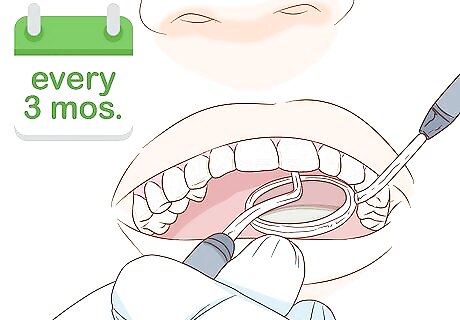
Get a professional dental cleaning every 3 months. If you have gum pockets, your dentist will likely suggest that you come in for a cleaning more often than you would if you didn’t have them. Make an appointment with your dentist and have your teeth cleaned so that your gums have an easier time healing. Professional dental cleanings are more effective than at home cleaning because they focus on cleaning below the gum line. Getting a cleaning every 6 months will also help your dentist keep an eye on your gum pockets and assess whether additional treatment is needed.

Have scaling and root planing done. If your gum pockets are more than 4mm deep, your dentist may suggest a more in depth cleaning than is typically done. Scaling and root planing cleans the surface of the tooth under the gum line but also smooths out the root surface so that your gums can reattach and the pocket can shrink. Scaling and root planing can be slightly painful, so your dentist may numb your gums with a topical anesthetic or a local anesthetic, depending on how much work needs to be done.
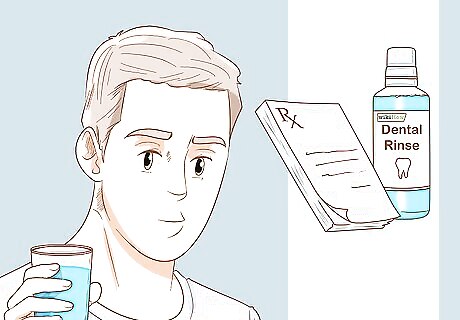
Use a dental rinse or medication prescribed by your dentist. In some cases, following your rooting and planing procedure, you will be told to rinse daily with a prescription mouthwash or to take antibiotic medication. Both of these treatments will help eliminate the infection in your gums that has caused the pockets to grow. Like all prescription medications, take the antibiotics or use the mouthwash for as long and as often as directed by your dentist. This will help ensure that the infection is totally eradicated.
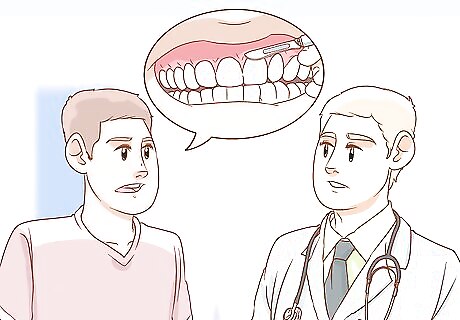
Have surgery if your gum pockets are threatening the integrity of your teeth. If your gum pockets are larger than 7mm, then it is likely that they are exposing the root of the tooth to bacteria. This can cause the tooth to fail over time, so your dentist may suggest surgery to reduce the size of the pockets. During this type of surgery, an oral surgeon with pull back the gums to access the root area of the tooth. They will then clean the area, planing the surface and removing any bacteria present. Then they will put the gums back, using sutures to hold them in place. This is typically only suggested as a last resort to try and save your teeth, so take the suggestion seriously and have the surgery done if you can.
















Comments
0 comment